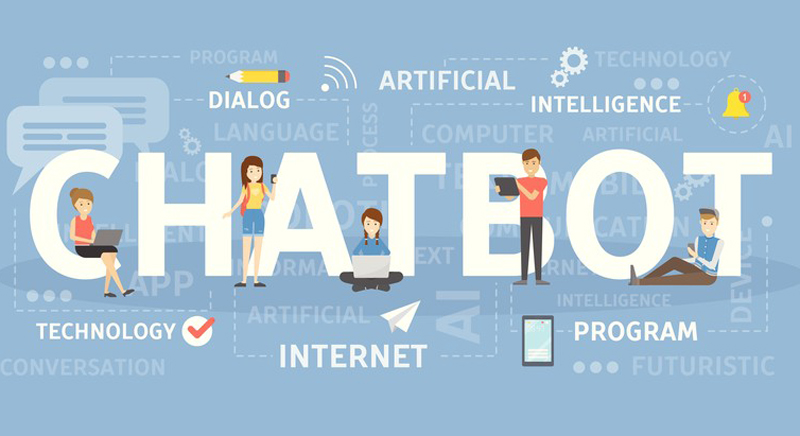As a business transcription company, we provide periodic updates on emerging technologies impacting various industries. Chatbots are one of the most publicized trends of the future, gaining pace in recent years as a popular customer service agent in the world of entertainment, media, retail, health, legal services, banking, real estate, insurance, hospitality, and travel. According to a June 2018 Forbes report, 8 in 10 companies have implemented chatbots or are planning to do so by 2020, and 15% of customers have interacted with a chatbot in the last 12 months. McKinsey estimated that companies are saving up to 29% on customer service by adopting bots.
Powered by artificial intelligence (AI), a chatbot is a program that can have a conversation with a customer, just like a human being via a chat interface. Well-designed bots can send texts, images, audios, links and messages in real time in response to users’ queries. Some of the key areas where chatbots are calling the shots in customer service are:
- As a shopping assistant, providing basic information about a company, product or service
- Confirming a purchase
- Checking if a product is available at a local store
- Finding new restaurants or locating the best place to buy a favorite dish
- Scheduling a flight or booking a hotel
- Scheduling, changing, or tracking a shipment
- Requesting service at a hotel
- Ordering food online
- Providing recommendations on just about anything
Chatbots have ushered in a new way for businesses to communicate with their customers and the world at large. Used the right way, they can enhance customer satisfaction, save time and improve sales. The benefits of using chatbots for your business include:
- 24/7 customer support: Chatbots can help you save time, effort and money by allowing proactive customer interaction. If your company needs to provide full-time customer service, chatbots are a good option. With chatbots, you can initiate a conversation with each customer, concerning any issue, any time of the day. A chatbot can provide an instant response to customer queries 24/7, reduce wait time, and enhance customer satisfaction.
- Interactive service for frequently asked questions (FAQs): If your company provides high volume customer support, it can put a lot of stress on a live team. With a chatbot, you would have an interactive service for FAQs. Your customers can get answers to their queries without having to search through multiple lists.
Chatbots may not be able to handle all customer queries, but they can be trained to deal with many routine questions. Accenture gives the example of a European telecommunications company where a chatbot that was used in a pilot program on a set of common customer queries resolved 82% on interactions when combined with live intervention with a human agent. With metrics about the types and volume of specific questions over time, chatbots can be programmed to provide answers to potential new questions. - Support to easily navigate business website: Having a chatbot within your company’s website can make it easier for visitors to navigate the site and customize their experience. People come to a business website because they want specific information. They could have questions about a product or its uses, need some technical support, or want to talk to someone in sales. A properly implemented chatbot can efficiently direct customers to solutions, serving their needs quickly and in real-time to increase satisfaction.
- Convenience: Accenture points out that chatbots make it easy for customers to reach businesses using the messaging services that they use on a routine basis. Many people, especially the elderly, find chat easier to use than apps and websites. Chatbots allow them to interact easily with the business using a more natural method.
- Insights regarding customer needs: Compared to email, messenger chatbots have higher open rates and click through rates. Chatbots collect authentic information about customer preferences and interests by analyzing their queries and adapting to their needs. They are far more personal than social media as users may be more expressive about their feeling on a chatbot. This gives brands a better opportunity to develop a more personal relationship with their customers, allowing them to deliver personalized services, increase customer loyalty, and remain competitive.
- Reduced errors: Humans can make mistakes when handling customer queries. Chatbots are designed with smart algorithms and programming and have access to vast resources. They process the data accurately and can answer customers’ questions correctly. Chatbots reduce risk of errors.
- Cut costs: Having a customer service or technical support team on the job 24/7 can be costly. Chatbots help reduce costs by reducing and even replacing several human service agents. Moreover, it takes time to train manpower, while a chatbox and can trained in a few hours or a day.
Many brands are successfully using chatbots for customer service. Starbucks has its chatbot inside the Starbucks app. It allows you to place an order for your favorite snack or drink very easily using either text messaging or voice commands. If you want to get tickets to a new movie, go to Fandango. Just enter your city or zip code and the chatbot of this American corporation will show you what’s playing in local theatres and allow you to watch trailers and book tickets. Spotify’s Facebook Messenger bot helps music lovers find the genre of music they want and share it. It even provides playlist recommendations based on your mood!
If you intend to implement chatbots to replace your customer service team, you need to provide them with a robust support system. To work effectively and provide consistent results, chatbots need an organized support structure. Therefore to succeed with chatbot implementation, you need to consistently organize and update the information for the chatbot to access. Chatbots also need time to learn from customer’s feedback and behavior. Experts recommend that the best strategy is to begin small by testing the service on certain channels and then work on extending it.
It’s clear that AI works best when it works with large data sets like text that can be analyzed. A recent/www.techemergence.com report points out that a lot of data is in the form of audio and video recordings and digital transcription is required to convert them into text format. Digital transcription services are already widely used in the medical, legal, media and other fields. As the report rightly notes, the emergence of machine learning has made reliable audio transcription services an important goal for artificial intelligence.




